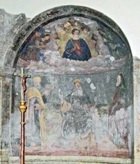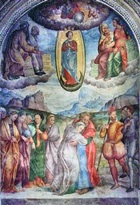

Adone (Dono) Doni, who was born in Assisi, was first documented in 1530 as an assistant of Giovanni di Pietro, lo Spagna at San Giacomo di Spoleto (see below). He became the pre-eminent Umbrian-born painter of the late Renaissance.
Dono Doni wrote a guide to the art in the Basilica of San Francesco, Assisi that survived in the archives there until at least 1882. He must have been an early contributor to what has become known as the “Giotto Question” - did Giotto, or did he not, paint the scenes from the life of St Francis in the Upper Church? The earliest surviving assertion that he did occurs in the second edition (1568) of Giorgio Vasari’s “ Lives of the Artists”, which he wrote after he had visited Assisi in 1563 and 1566:
-
✴Dono Doni almost certainly hosted Vasari during his visits to Assisi: in the 2nd edition, Vasari commented that Dono Doni’s “gentleness and good manners have caused him to be considered liberal and courteous”. It is hard to imagine that they did not discuss the matter.
-
✴Dono Doni was also an important advisor to Fra. Ludovico da Pietralunga, whose guide (ca. 1575) to the basilica still survives. This guide also attributed the St Francis Cycles to Giotto.
Fra. Ludovico did not slavishly follow Vasari in his attributions. Significantly, when he differed from Vasari in attributing a (now lost) work in Santa Chiara to Puccio Capanna, he justified his position in part by citing the reasoned opinion of none other than Dono Doni. Thus, if Fra. Ludovico agreed with Vasari about the attribution of the St Francis Cycle to Giotto, it is a safe bet that he was following Dono Doni in doing so. Indeed, Dono Doni might well have been the first of the three men to make this attribution.
Assisi
Scenes from the Life of St Francis (1541)
Giorgio Vasari considered these documented frescoes on the exterior wall of the Cappella del Transito, Santa Maria degli Angeli to be Dono Doni’s best works. They may have been damaged in the earthquake of 1832, which would explain why they were over-painted in 1889.
Works in San Rufino
The following works by or attributed to Dono Doni are in San Rufino.
Christ in Glory with saints (1555)

-
✴Christ in Glory with SS James and John the Evangelist (above), and
-
✴an angel bestowing the palm of martyrdom of St Rufinus, with SS Vitalis, Antony Abbot, Francis and Clare (below).
Its predella has been lost.
Crucifix (1561)

Deposition (1563)
The Confraternita di San Gregorio commissioned this altarpiece from Dono Doni for their Altare di San Gregorio Magno (at the head of the left aisle). It was moved to the Altare di San Vitale (in the presbytery) when its original altar was destroyed in 1848.
-
✴The main panel, which was restored in 2004, depicts the body of Christ after its removal from the cross, surrounded by mourners.
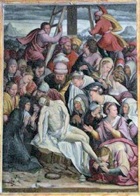
-
✴The predella, which was detached from the main panel in 1848, is now in the Museo Diocesano. It depicts St Gregory the Great with members of the confraternity.

Crucifixion (1563)
The Confraternita di San Lorenzo commissioned this altarpiece from Dono Doni for their Altare di San Lorenzo (in the right aisle). It was moved to the Altare di San Rufinuccio (in the presbytery) when its original altar was destroyed in 1848.
-
✴The main panel, which was restored in 2004, depicts the Crucifixion of Christ and the two thieves in front of a cityscape of Jerusalem, with St Mary Magdalene at the foot of the Cross, St John the Evangelist to the right and the swooning Madonna to the left.
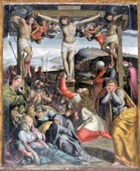
-
✴The predella, , which was detached from the main panel in 1848, is now in the Museo Diocesano. It depicts St Laurence with members of the confraternity.

St Joseph (early 16th century)
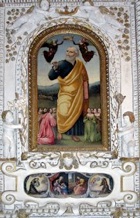
The predella (mid 16th century), which depicts the Holy Family with SS Antony of Padua and Bernardino of Siena, is more securely attributed to Dono Doni.
Altarpieces from the Chapel of Palazzo dei Priori (1565-6)
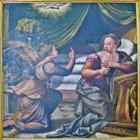
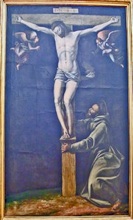
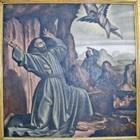
These altarpieces from the chapel of the Palazzo dei Priori, which are now in the Pinacoteca Comunale, are attributed to Dono Doni. They depict:
-
✴the Annunciation, which is dated by inscription;
-
✴the Crucifixion with St Francis; and
-
✴the Stigmatisation of St Francis.
Crucifixion (ca. 1560)
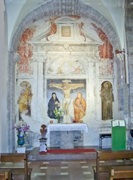
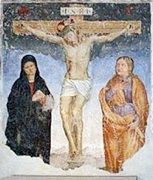
This fresco of the Crucifixion with the Virgin and St John the Evangelist on the Altare di San Giuseppe of Santa Maria Maggiore, which is attributed to Dono Doni, was discovered under plaster during the restoration that followed the earthquake of 1997. Unfortunately it has been over-restored: this probably occurred in 1640, when the fictive altar surrounding it was executed.
Works in San Francesco
Scenes from the lives of SS Francis and Clare (1564-70)
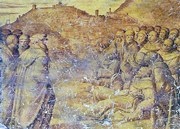
These damaged monochrome frescoes by Dono Doni are in the cloister of the Sacro Convento di San Francesco. The scene illustrated here depicts St Francis blessing Assisi as he is carried to the Portiuncula to die. The gallows on the hillside at the extreme left, below the Rocca Maggiore, stand on the site on which the Basilica di San Francesco would be built.
Scenes from the Life of St Stephen (1575)
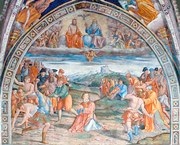
The Confraternita di Santo Stefano commissioned these frescoes from Dono Doni for the Cappella di Santo Stefano in the Lower Church of San Francesco. Dono Doni died in the following year and the work was completed by his workshop. The scenes, which are in the lunettes and read from right to left, depict:
-
✴St Stephen disputing with the doctors in the synagogue;
-
✴St Stephen expelled from Jerusalem; and
-
✴the stoning of St Stephen (illustrated here).
The frescoes in the vaults, which depict Prophets and Sibyls, are also by Dono Doni.
Fresco fragment (16th century)
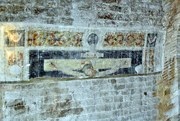
The surviving upper part of this fresco of the Crucifixion on the left wall of Santo Stefano is attributed to Dono Doni.
Fresco of St Paul (16th century)
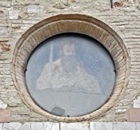
SS Paul, Benedict and Laurence Giustiniani (late 16th century)

From Assisi
Processional Banner (ca. 1550)
This banner was documented in 1865, with an attribution to Dono Doni, after its removal from the Oratorio di San Lorenzo. It was subsequently lost, until Francis Russell (referenced below) drew attention to its appearance in a public sale in New York in 1978. He suggested that it had been painted ca. 1550.
The banner, which is now in a private collection, depicts:
-
✴the Crucifixion with the Virgin and St John the Evangelist, with St Mary Magdalene at the foot of the cross, in the upper part of the composition; and
-
✴six saints (including SS Francis, Clare, Rufinus and Victorinus) and members of the confraternity below.
Bettona
Adoration of the Shepherds (1543)
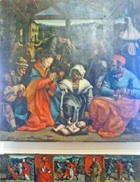
-
✴The main panel depicts the Virgin, an elderly nurse and St Joseph together with three shepherds, kneeling in a semi-circle behind the baby Jesus, who lies on the floor of the stable in which He was born.
-
✴The predella contains scenes from the life and martyrdom of St Crispoltus.
Bevagna
Ciccoli Altarpiece (ca. 1565)

The altarpiece commemorates a nephew of Gisberto Ciccoli who had died when only ten: the boy is shown at the Virgin’s knee receiving the blessing of the baby Jesus. Gisberto was a doctor, and one can sense his grief at having been unable to save his nephew: two inscriptions below the arms of the Ciccoli and Sermattei families lament his early death.
Foligno
Nativity with St Lucy (1544)
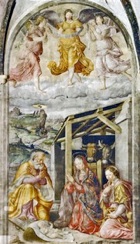
Frescoed Frieze (ca. 1545)
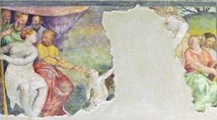
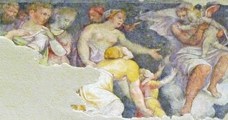
This frieze in the Sala Papale of Palazzo Trinci came to light during recent renovations. It seems the depict allegories of sacred and profane love, although the precise meaning and source for the narrative cannot be determined, not least because much of the work has been lost. The frescoes are attributed on stylistic grounds to Dono Doni.
Martyrdom of St Catherine of Alexandria (16th century)
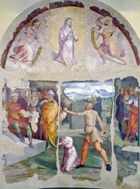
Gubbio
The following are in the Duomo:
Pietà (after 1560)
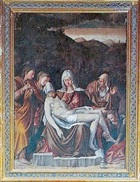
Way to Calvary (ca. 1564)
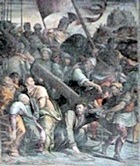
Perugia
Frescoes in Rocca Paolina (1543-4)
Giorgio Vasari reports that Lattanzio Pagani began the decoration of the newly built Rocca Paolina. Cristofano Gherardi, il Doceno (who was a close associate of Vasari) “not only assisted ... Lattanzio, but afterwards executed with his own hand the greater part of the best works that are painted in the apartments of that fortress, in which there also worked Raffaellino del Colle and Adone Doni of Assisi, an able and well-practised painter .... Tommaso [Bernabei, il] Papacello also worked there ...”
This is the only surviving record of the commissioning of the frescoes of Rocca Paolina. Paul III had built the fortress after his subjugation of the rebellious Perugians in 1540, so it is unsurprising that the team included no Perugian artists: indeed, apart from Dono Doni, all the artists came from outside Umbria. They were to spearhead the introduction of Mannerist art to the city of Perugino. Unfortunately, all of their work here was lost when the fortress was demolished in 1860.
Vasari is explicit the work had been commissioned by “Messer Tiberio Crispo, who was governor and castellan at that time”. A number of considerations suggest that the time in question was 1543-4:
-
✴Serafino Siepi, who described the surviving and frescoes in his guide of 1822, says that those in the chapel (which he attributed to Dono Doni) were dated by inscription to 1543;
-
✴Giorgio Vasari says that he called Cristofano Gherardi from Perugia to Rome in 1543, where he stayed for “many months”;
-
✴Raffaellino del Colle is documented in Perugia in June 1544;
-
✴Tiberio Crispo became a cardinal in December 1544, after which the title “Messer” would have been inappropriate; and
-
✴Giorgio Vasari called Cristofano Gherardi and Raffaellino del Colle (whom he describes as his “friends and pupils”) to Naples in 1545, albeit that Cristofano was too ill to respond.
If this is correct, Vasari’s reference to Tiberio Crispo as “governor and castellan” was either incorrect or perhaps was a reference to Tiberio Crispo’s position at Castel Sant’ Angelo, Rome in 1542-5. He energetically promoted the decoration of the Roman fortress during his tenure, and might also have had responsibilities at Rocca Paolina before his appointment as Cardinal Legate of Perugia (1545-8).
Birth of the Virgin (1561)
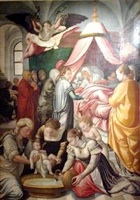
Fresco (1572)
In 1572, Dono Doni received payment for a “historia penta” (history painting) in the Sala Rossa of Palazzo dei Priori. This must have been the magnificent fresco of the Decemviri thanking Pope Julius III for restoring the civic rights of Perugia, which survives in situ. The faces of the participants seem to be realistic portraits. It seems likely that the predominance of red in this composition led to the naming of the room itself.
Altarpieces from San Francesco al Prato (16th century)
Immaculate Conception (1558)
Marsia di Ridolfo commissioned this altarpiece from Dono Doni for her altar in San Francesco al Prato. It depicts the standing Virgin surrounded by angels, with a collection of prophets, sibyls and scholars below. A scroll under her feet proclaims her immaculate conception. It was removed in 1863 and entered the Galleria Nazionale in 1872.
Last Judgement (16th century)
This altarpiece, which is attributed to Dono Doni, was recorded in the Cappella degli Baldeschi in San Francesco al Prato in 1683. It was moved to the choir during the restoration of 1740-8. It was removed in 1863 and is now in the Galleria Nazionale.
Spello
Madonna and Child with saints (ca. 1540)
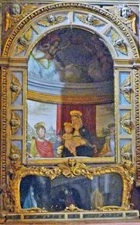
Virgin and St Joseph (1565)
Spoleto
Virgin in glory with saints (1530)
